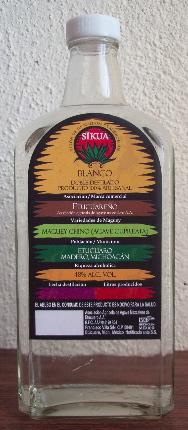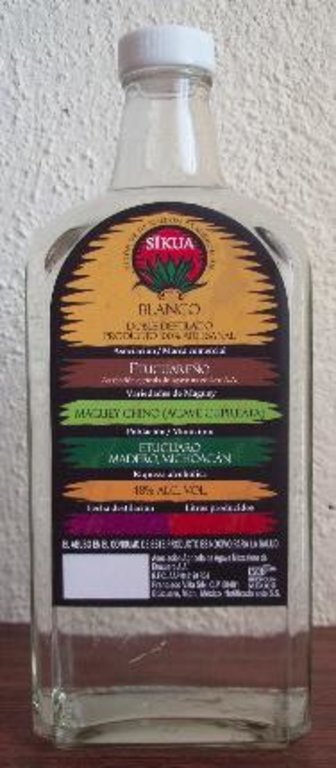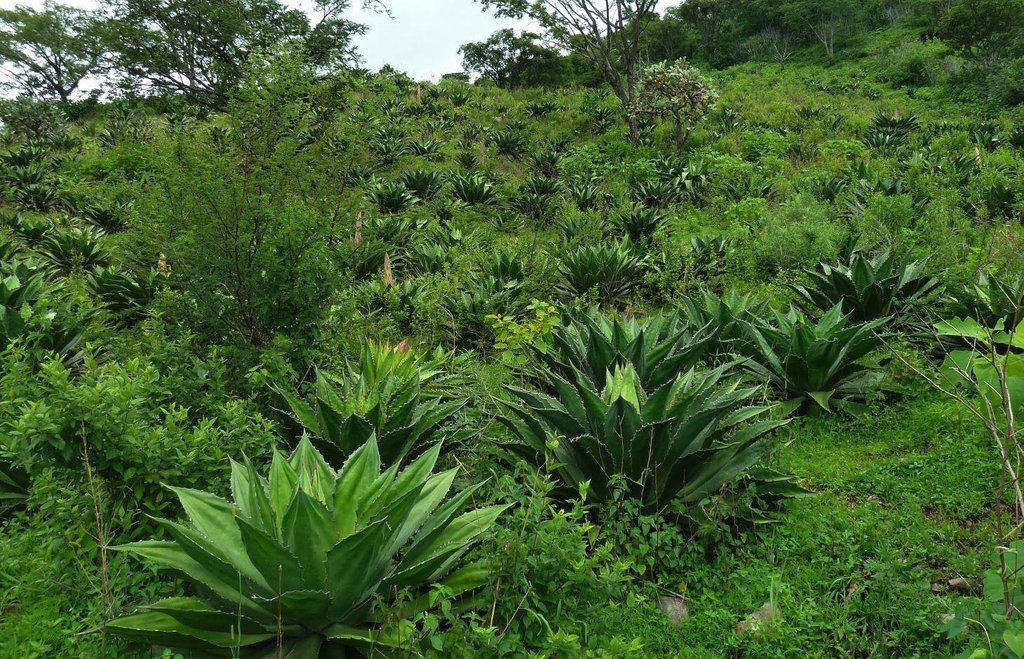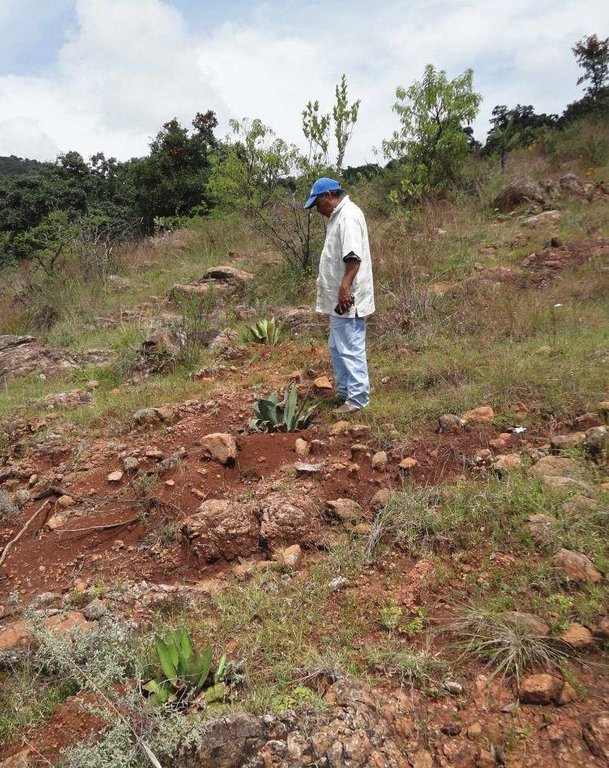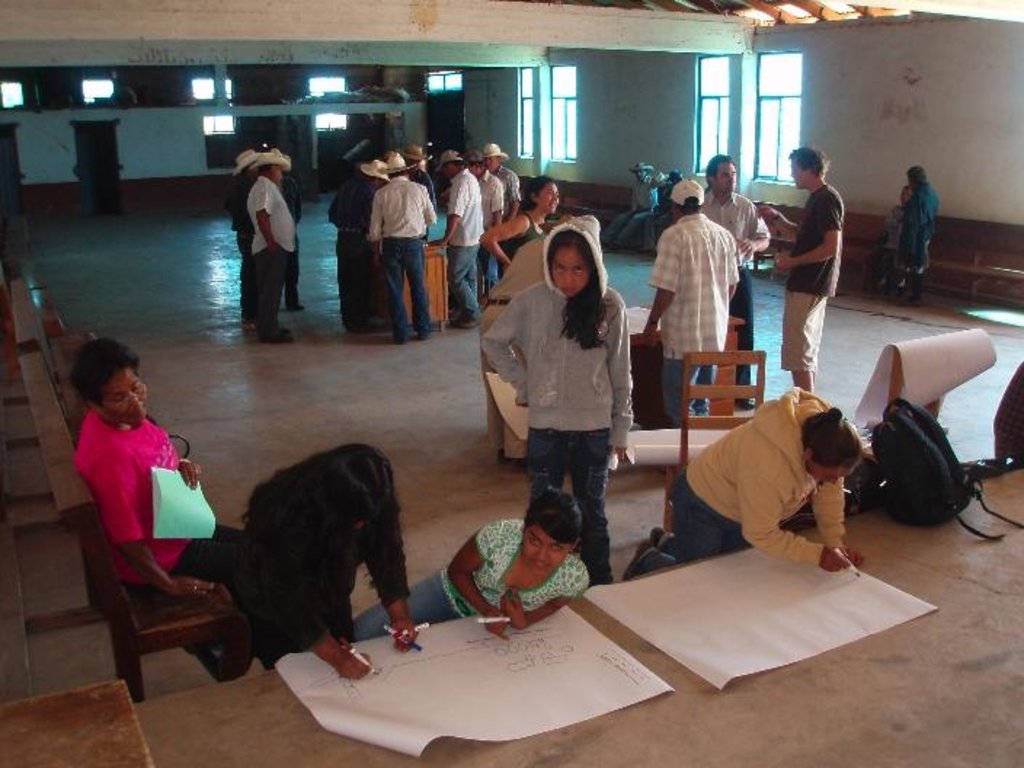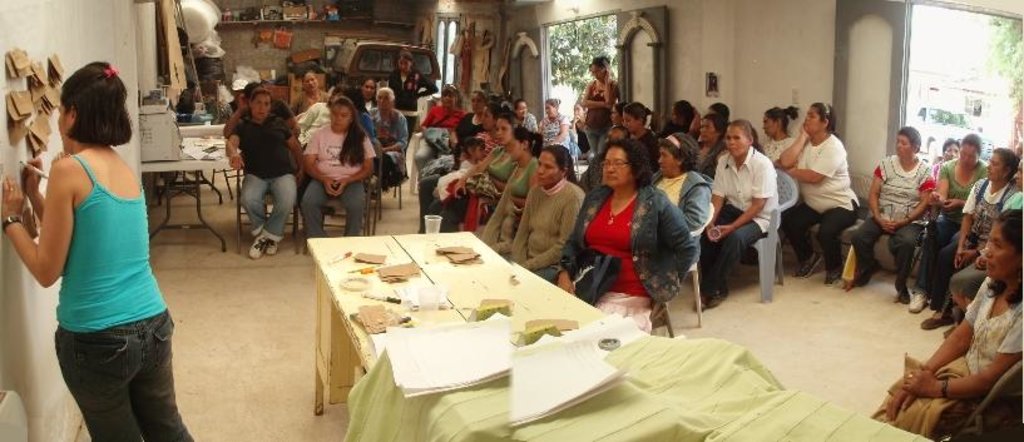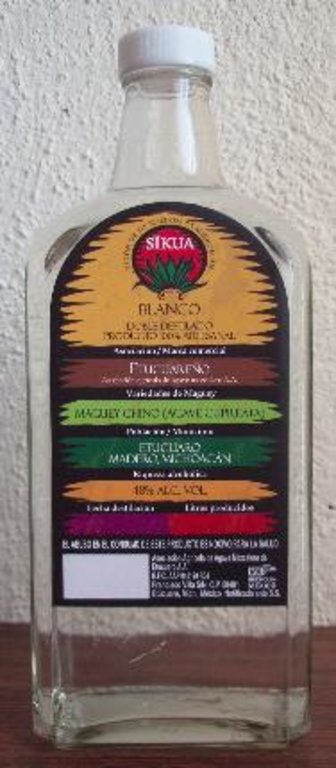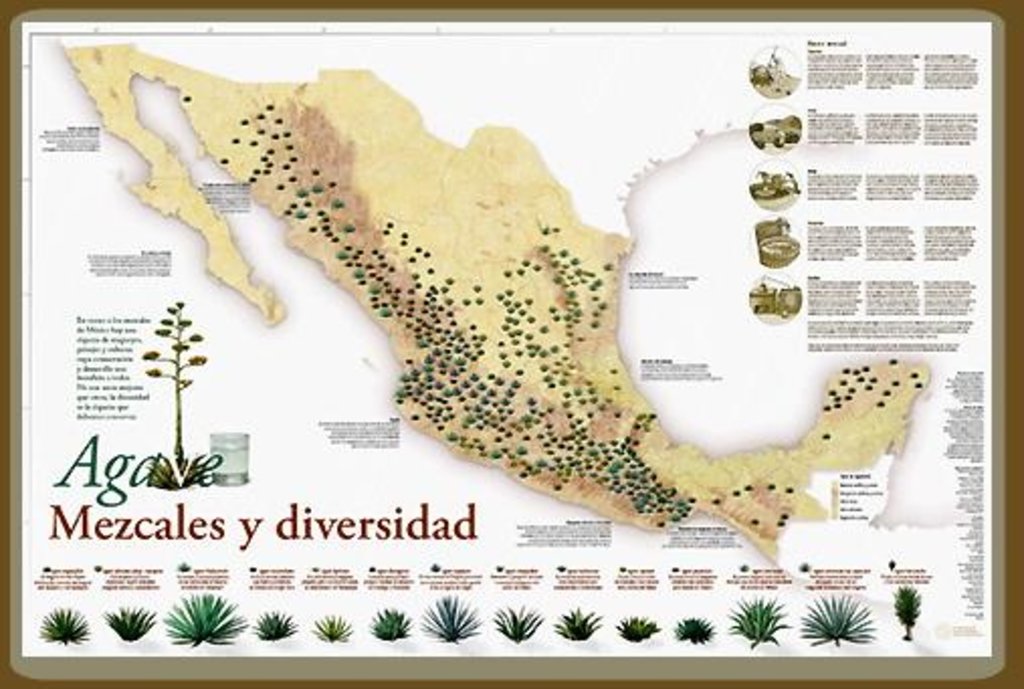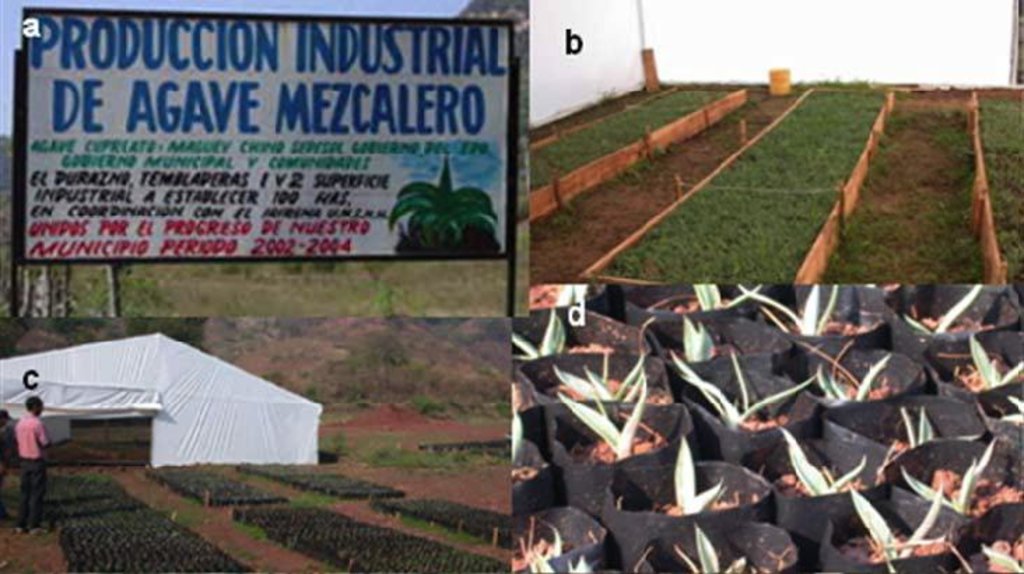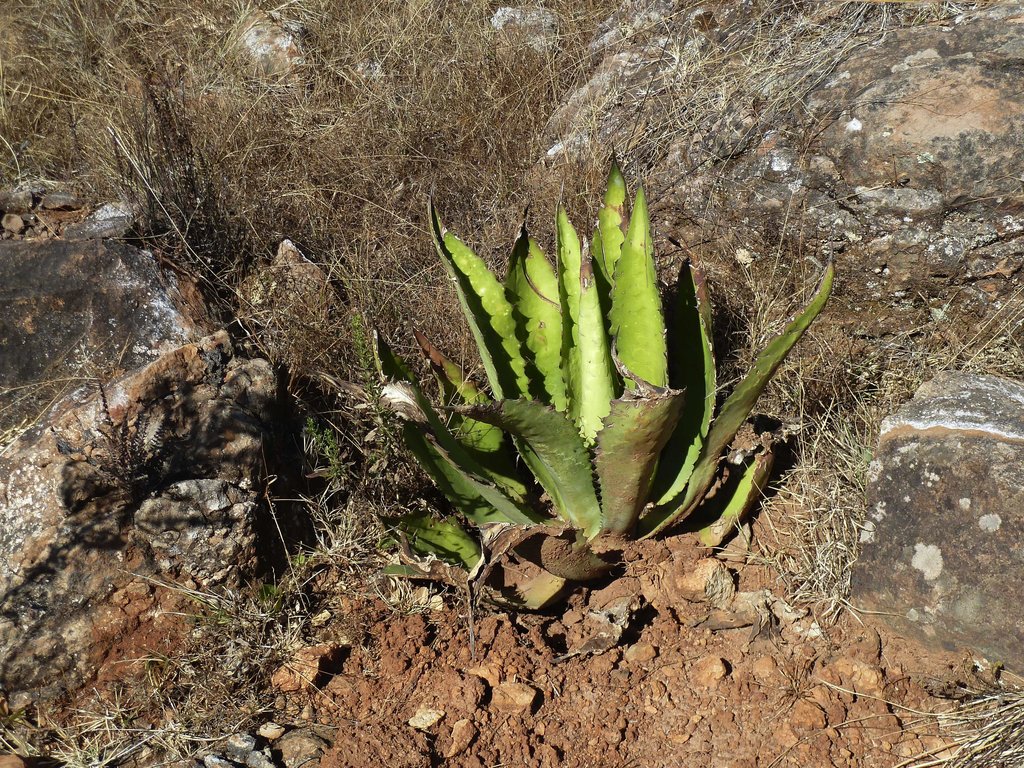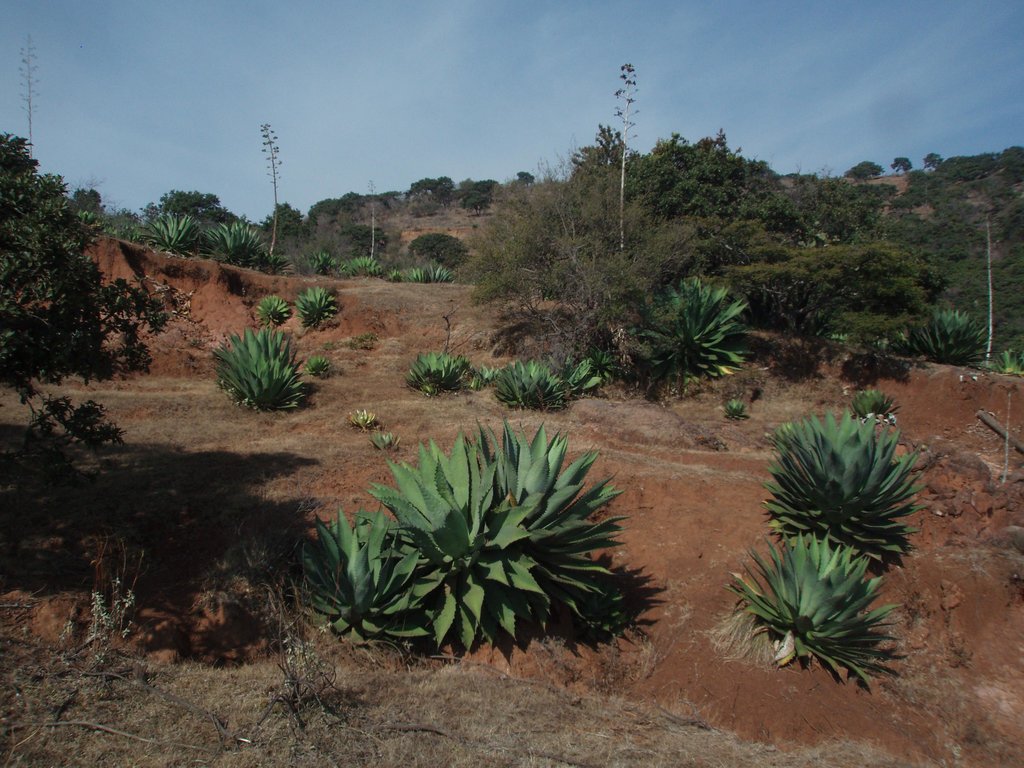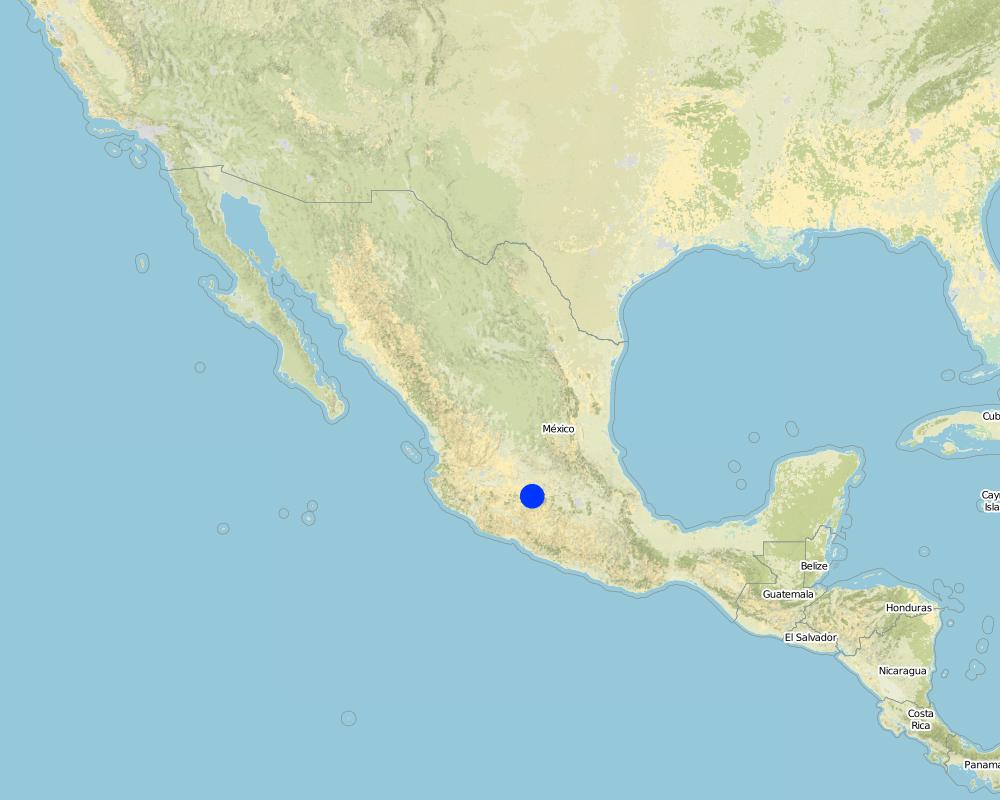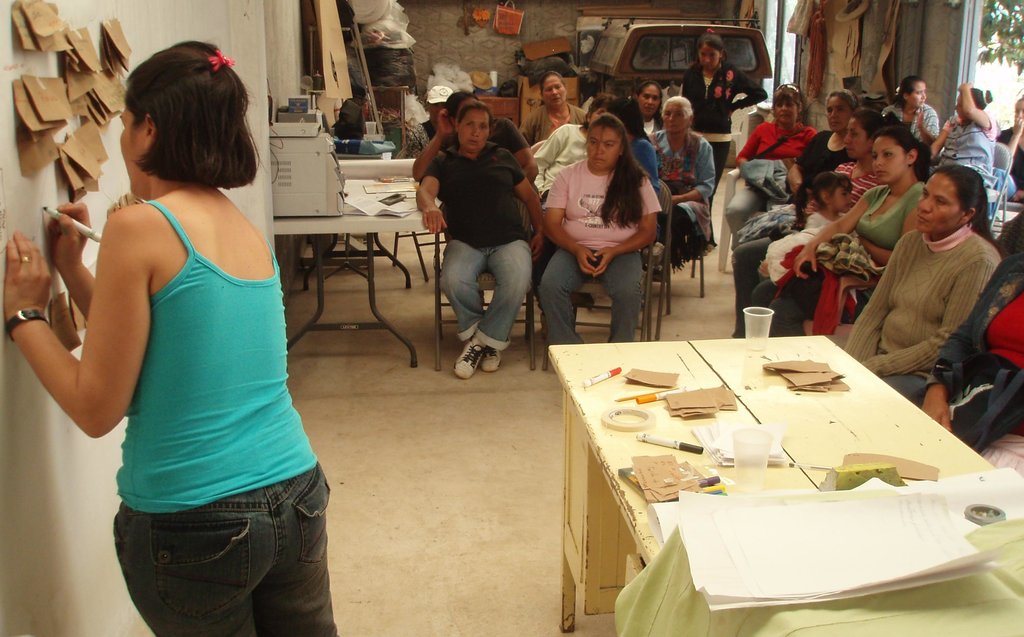Participative actions for economic benefits of agave forestry [ប្រទេសម៉ិកស៊ិក]
- ការបង្កើត៖
- បច្ចុប្បន្នភាព
- អ្នកចងក្រង៖ Christian Prat
- អ្នកកែសម្រួល៖ –
- អ្នកត្រួតពិនិត្យ Fabian Ottiger
Recuperación de tierras degradadas por agaveforestería a través de acciones participativas para beneficios económicos (Spanish)
approaches_2436 - ប្រទេសម៉ិកស៊ិក
ពិនិត្យមើលគ្រប់ផ្នែក
ពង្រីកមើលទាំងអស់ បង្រួមទាំងអស់1. ព័ត៌មានទូទៅ
1.2 ព័ត៌មានលម្អិតពីបុគ្គលសំខាន់ៗ និងស្ថាប័នដែលចូលរួមក្នុងការវាយតម្លៃ និងចងក្រងឯកសារនៃវិធីសាស្ត្រផ្សព្វផ្សាយ
អ្នកជំនាញឯកទេស SLM:
Martínez Palacios Alejandro
Tel (443) 334-0475, Ext. 119
apalacios56@gmail.com
Instituto de Investigaciones Agropecuarias y Forestales, Universidad Michoacana de San Nicolás de Hidalgo (IIAF-UMSNH)
Morelia-Zinapecuaro, Tarímbaro, Michoacán 58330, México
ប្រទេសម៉ិកស៊ិក
អ្នកជំនាញឯកទេស SLM:
Ríos Patrón Eduardo
01 (443) 3226017
eduardo.rios@semarnat.gob.mx
Delegación de SEMARNAT (Secretaria del Medio Ambiente) en Michoacán, Unidad de Planeación y Política Ambienta
Morelia, Michoacán
ប្រទេសម៉ិកស៊ិក
ឈ្មោះគម្រោងដែលបានចងក្រងឯកសារ/ វាយតម្លៃលើវិធីសាស្ត្រផ្សព្វផ្សាយ (បើទាក់ទង)
DESIRE (EU-DES!RE)ឈ្មោះអង្គភាពមួយ (ច្រើន) ដែលបានចងក្រងឯកសារ/ វាយតម្លៃលើវិធីសាស្ត្រផ្សព្វផ្សាយ (បើទាក់ទង)
Institut de recherche pour le développement IRD (Institut de recherche pour le développement IRD) - ប្រទេសបារាំងឈ្មោះអង្គភាពមួយ (ច្រើន) ដែលបានចងក្រងឯកសារ/ វាយតម្លៃលើវិធីសាស្ត្រផ្សព្វផ្សាយ (បើទាក់ទង)
Instituto de Investigaciones Agropecuarias y Forestales (IIAF) - ប្រទេសម៉ិកស៊ិកឈ្មោះអង្គភាពមួយ (ច្រើន) ដែលបានចងក្រងឯកសារ/ វាយតម្លៃលើវិធីសាស្ត្រផ្សព្វផ្សាយ (បើទាក់ទង)
SECRETARÍA DE MEDIO AMBIENTE Y RECURSOS NATURALES (SECRETARÍA DE MEDIO AMBIENTE Y RECURSOS NATURALES) - ប្រទេសម៉ិកស៊ិក1.3 លក្ខខណ្ឌទាក់ទងទៅនឹងការប្រើប្រាស់ទិន្នន័យដែលបានចងក្រងតាមរយៈវ៉ូខេត
អ្នកចងក្រង និង(បុគ្គលសំខាន់ៗ)យល់ព្រមទទួលយកនូវលក្ខខណ្ឌនានាទាក់ទងទៅនឹងការប្រើប្រាស់ទិន្នន័យដែលបានចងក្រងតាមរយៈ វ៉ូខេត:
បាទ/ចា៎
1.4 ការយោងមួយ (ច្រើន) ទៅលើ (កម្រង) បញ្ជីសំណួរនៃបច្ចេកទេស SLM

Land reclamation by agave forestry with native species [ប្រទេសម៉ិកស៊ិក]
Agave forestry land reclamation system with native agaves, trees, shrubs and grasses planted through participatory action for a sustainable production of mezcal and other products in order to generate high incomes for farmers.
- អ្នកចងក្រង៖ Christian Prat
2. ការពណ៌នាអំពីវិធីសាស្ត្រផ្សព្វផ្សាយ SLM
2.1 ពណ៌នាសង្ខេបខ្លីពីវិធីសាស្ត្រផ្សព្វផ្សាយ
Land reclamation with local agave (to produce Mezcal) associated with trees, shrubs and grasses planted through participative actions for economic benefit.
2.2 ពណ៌នាលម្អិតពិវិធីសាស្ត្រផ្សព្វផ្សាយ
ពណ៌នាលម្អិតពិវិធីសាស្ត្រផ្សព្វផ្សាយ:
Aims / objectives: Rehabilitation of degraded land is achieved by using native agave (Agave inaequidens) and trees, shrubs and grasses which creates, over the medium-term (7-10 year), a sustainable production of an alcoholic drink (mezcal) and/or pharmaceutical products and/or fodder for cattle and/or wood. Further objectives are water conservation, biodiversity, generation of permanent employment (plant reproduction, planting, alcoholic drink/ pharmaceutical production), carbon sequestration, generation of higher family incomes and a reduction in the amount of livestock and number of animals and uncontrolled grazing (the main cause of soil erosion). These positive impacts of the approach contribute to preventing the rural population from emigrating to the cities or abroad.
Methods: Coordination, cooperation and systematic participatory process among stakeholders are the basis of the approach. Promoting participatory processes occurs through workshops, interviews with community leaders, field visits conducted with owners of the land to recognize the problems and identify areas of opportunity, training courses, exchange of experiences with other people who are developing similar projects at different stages. Technical advice and the links with scientists, technicians and public officials in charge of project beneficiaries is given under a two-way process of mutual learning and seeking to strengthen self-management capabilities that inspires innovation at the different stages. The key to success of a participatory approach lies in liberating and developing community leadership and self-organization processes.
Stages of implementation: The project is part of a regional planning context and a basin scale approach of intervention. The watershed of the site project is included in a special programme of the Ministry of Environment and Natural Resources of Mexico which gives the opportunity of developing and financing a medium- to long-term project. The participatory process is delivered from planning, organizing, programming and implementing to financing, training, monitoring and disseminating the results. The strategic perspective of the project includes capacity-building of land owners for greenhouse and nursery management, the technical assessment for the improvement of the agave forestry system, guidance with quality production of mezcal and marketing support to diversify products and sell them in order to make the project financially self-sustaining and profitable. All these stages range from short- to medium- and long-term.
Role of stakeholders: The government finances the project through grant resources, promotes the participation of beneficiaries and monitors it, seeking the management of resources and intersectoral participation. Scientists and academics share their knowledge, techniques and methodologies for implementation, improvement, evaluation and monitoring of each stage, and they support capacity-building of the community. The owners of the land and the community implement and develop each of the activities from building and maintaining the greenhouse and nursery, planting agaves, trees and shrubs, to the use and production of mezcal and other commercial products.
2.3 រូបភាពនៃវិធីសាស្ត្រផ្សព្វផ្សាយ
2.5 ប្រទេស/តំបន់/ទីតាំងកន្លែង ដែលវិធីសាស្ត្រផ្សព្វផ្សាយត្រូវបានអនុវត្តន៍
ប្រទេស:
ប្រទេសម៉ិកស៊ិក
តំបន់/រដ្ឋ/ខេត្ត:
Mexico/Michoacán state
បញ្ជាក់បន្ថែមពីលក្ខណៈនៃទីតាំង:
Morelia
Map
×2.6 កាលបរិច្ឆេទនៃការចាប់ផ្តើម និងបញ្ចប់នៃវិធីសាស្រ្តផ្សព្វផ្សាយនេះ
សូមបញ្ជាក់ឆ្នាំដែលបានបង្កើតឡើង:
2009
ឆ្នាំបញ្ចប់ (ប្រសិនបើវិធីសាស្ត្រផ្សព្វផ្សាយត្រូវបានឈប់ប្រើប្រាស់):
2012
2.7 ប្រភេទនៃវិធីសាស្ត្រផ្សព្វផ្សាយ
- Traditional, innovative and project based
2.8 គោលបំណង/ទិសដៅសំខាន់នៃវិធីសាស្ត្រផ្សព្វផ្សាយ
The Approach focused mainly on other activities than SLM (registered alcohol production, cattle fodder, medicine uses, biodiversity conservation, wood)
Rehabilitation of degraded land is done using native agave (Agave inaequidens), trees, shrubs and grasses which creates, over the medium-term (7-10 years) sustainable production of an alcoholic drink (mezcal) and/or pharmaceutical products and/or fodder for cattle and/or wood.
The SLM Approach addressed the following problems: Social and economic problems: Agriculture and livestock in the region are primarily for subsistence. The level of poverty and marginalization of the people of the project site is medium to high with low education levels. People need to migrate to the cities or outside the country to supplement the family budget. Prices of farmer productions are too low and do not allow economic survival. Therefore, only 10 to 20% of the total incomes are derived from agricultural products! This explains why the children of farmers do not want to become farmers and lands are less and less cultivated. In correlation, as the livestock price is good and animals can be raised with little input of time. Thus the number of animals is increasing and as they are grazing everywhere, they have a strong soil erosion impact.
2.9 លក្ខខណ្ឌអនុញ្ញាត ឬរារាំងការអនុវត្តន៍បច្ចេកទេសដែលស្ថិតនៅក្រោមវិធីសាស្រ្តផ្សព្វផ្សាយ
សង្គម/វប្បធម៌/ និងតម្លៃនៃសាសនា
- រារាំង
The social arrangement of the “ejido” requires all people to agree on moving forward with different activities. The level of education and migration.
Treatment through the SLM Approach: Systematic and constant promotion of the participatory process through community assembly meetings, workshops, community exchange travel, experiences and training. Promote complementarity and targeting of resources from other sectors.
ភាពអាចរកបាននៃធនធានហិរញ្ញវត្ថុ និងសេវាកម្ម
- រារាំង
Potential constraints in the final stages of the project when receiving revenue from the sale of mezcal and other products.
Treatment through the SLM Approach: Strengthening capacities of organization and administration, promoting transparency and accountability in the community. Development and consolidation of the formation of cooperatives as an alternative to social enterprise.
បរិបទនៃស្ថាប័ន
- រារាំង
The risk that the six-year change in administration does not follow the care programme in the area.
Treatment through the SLM Approach: Strengthening self-management capabilities of the group of beneficiaries of the project. Involving other government levels and sectors funding training and monitoring of subsequent stages.
ក្របខណ្ឌច្បាប់ (សិទ្ធិកាន់កាប់ដីធ្លី កម្មសិទ្ធីប្រើប្រាស់ដីនិងទឹក)
- អំណោយផល
The existing land ownership, land use rights / water rights greatly helped the approach implementation
- រារាំង
Federal, state and municipal regulations for preventing clearance of woods, biodiversity uses, forest exploitation, water concessions and water quality must be applied. Mexican official standards of mezcal production must be used
Treatment through the SLM Approach: Conduct a thorough review with a focus on prospective different stages of a project and the legal implications and regulations that must be met at these stages. Inform land owners about their rights, obligations and mechanisms of fulfilment.
ចំណេះដឹងស្តីពី SLM និងការទទួលបានការគាំទ្រផ្នែកបច្ចេកទេស
- រារាំង
Lack of validation and technology transfer of agave forestry. Lack of information on the requirements of these species of agave. Potential risk to move from non-intensive system to an intensive one due to economic and market factors.
Treatment through the SLM Approach: Development of technological packages for an agave forestry system as a basis for the production of mezcal, considering soil erosion levels and system arrangements. Promote only ecologically diversified, non-intensive systems. Design environmental and ecological monitoring stage.
3. ការចូលរួម និងតួនាទីរបស់ភាគីពាក់ព័ន្ធ
3.1 អ្នកពាក់ព័ន្ធដែលបានចូលរួមក្នុងវិធីសាស្ត្រផ្សព្វផ្សាយ និងតួនាទីរបស់ពួកគេ
- អ្នកប្រើប្រាស់ដីក្នុងតំបន់/សហគមន៍
Traditionally, women have been more responsible for the house and the area close to it. They are less involved in the field activities of the agave forestry project, but are involved in production and commercialization. On the other hand, women are worried about the possible impacts of alcoholic drink on communities, because alcoholism is a social concern. There has been no discrimination inside the communities up to now
- អ្នកឯកទេសគ្រប់គ្រងដីប្រកបដោយចីរភាព/ទីប្រឹក្សាបច្ចេកទេសកសិកម្ម
- គ្រូបង្រៀន/សិស្សក្មេងៗ/សិស្ស-និស្សិត
- វិស័យឯកជន
- រដ្ឋាភិបាលថ្នាក់មូលដ្ឋាន
- រដ្ឋាភិបាលថ្នាក់ជាតិ (អ្នករៀបចំផែនការ អ្នកសម្រេចចិត្ត)
- អង្គការអន្តរជាតិ
- administration and authorities; women
3.2 ការចូលរួមរបស់អ្នកប្រើប្រាស់ដីក្នុងតំបន់/ សហគមន៍ក្នុងតំបន់ក្នុងដំណាក់កាលផ្សេងគ្នានៃវិធីសាស្រ្តផ្សព្វផ្សាយ
| ការចូលរួមរបស់អ្នកប្រើប្រាស់ដីក្នុងតំបន់/សហគមន៍ក្នុងតំបន់ | សូមបញ្ជាក់នរណាត្រូវបានចូលរួម ព្រមទាំងពណ៌នាសកម្មភាពទាំងនោះ | |
|---|---|---|
| ការចាប់ផ្តើម/ការលើកទឹកចិត្ត | គំនិតផ្តួចផ្តើមដោយខ្ឡួនឯង | Balance alternatives and take decision to test the agave forestry |
| ការរៀបចំផែនការ | អន្តរកម្ម | Planning, organizing and programming the project, defining responsibilities, time and initial investment. Identification of agave seeds and a proper place to install the greenhouse and nursery. |
| ការអនុវត្តន៍ | គំនិតផ្តួចផ្តើមដោយខ្ឡួនឯង | Building and maintenance of greenhouse and nursery, selecting the sites for the plantation and planting. Training of land users by other land users to produce mescal according to quality rules for a recognized product. |
| ការត្រួតពិនិត្យ និងវាយតម្លៃ | គំនិតផ្តួចផ្តើមដោយខ្ឡួនឯង | In each field: monitoring plant growth, status of the protection against cattle grazing, indications of soil erosion. |
| Research | អន្តរកម្ម | Monitoring by some land users of some parameters defined by scientists. |
3.3 គំនូសបំព្រួញ (ប្រសិនបើមាន)
ការពណ៌នា:
Workshop with women from eight rural communities of the Calabozo - Potrerillos watershed. They are defining their problems and proposing solutions. EU-DESIRE project and small catchments SEMARNAT project, San Rafael Coapa community, Morelia municipality, April 2010
អ្នកនិពន្ធ:
Christian Prat
3.4 ការសម្រេចចិត្តលើការជ្រើសរើសបច្ចេកទេស SLM
តើការសម្រេចចិត្តក្នុងការជ្រើសរើសបច្ចេកទេស(ច្រើន)ត្រូវបានធ្វើឡើងយ៉ាងដូចម្តេច?
- all of them
ចូរពន្យល់:
It is the result of proposals, visits and discussions between all the stakeholders, so it is a joint decision.
Decisions on the method of implementing the SLM Technology were made by all of them. It is the result of proposals, visits and discussions between all the stakeholders, so it is a joint decision.
4. ជំនួយបច្ចេកទេស ការកសាងសមត្ថភាព និងការគ្រប់គ្រងចំណេះដឹង
4.1 ការកសាងសមត្ថភាព/ បណ្តុះបណ្តាល
តើវគ្គបណ្តុះបណ្តាលបានផ្តល់ឱ្យអ្នកប្រើប្រាស់ដី/អ្នកពាក់ព័ន្ធផ្សេងៗទៀតដែរឬទេ?
បាទ/ចា៎
សូមបញ្ជាក់តើអ្នកណាត្រូវបានបណ្តុះបណ្តាល:
- អ្នកប្រើប្រាស់ដី
- បុគ្គលិកចុះទីវាល/អ្នកផ្តល់ប្រឹក្សាយោបល់
ទម្រង់នៃការបណ្តុះបណ្តាល:
- អនុវត្តន៍ជាមួយការងារ
- ការប្រជុំជាសាធារណៈ
ប្រធានបទបណ្តុះបណ្តាល:
Training focused on explaining which plants to select for seeds, how to create and maintain plants in greenhouses, how to transplant them and how to organise their planting in the field depending on the aim (scattered for production or in rows to create a green barrier formed from trees, shrubs, grasses and agaves)
4.2 សេវាផ្តល់ប្រឹក្សាយោបល់
តើអ្នកប្រើប្រាស់ដីបានទទួលនូវសេវាផ្តល់ប្រឹក្សាដែរ ឬទេ?
បាទ/ចា៎
សូមបញ្ជាក់ប្រសិនបើសេវាកម្មប្រឹក្សាយោបល់ត្រូវបានផ្តល់ឱ្យ:
- នៅលើដីរបស់អ្នកប្រើប្រាស់ដី
ពណ៌នា/ពន្យល់:
Name of method used for advisory service: Plant (native agave, trees, shrubs, grasses) production advises; Key elements: Plant selection, Management of plants under greenhouse
Advisory service is very adequate to ensure the continuation of land conservation activities
4.3 ការពង្រឹងសមត្ថភាពស្ថាប័ន (ការអភិរឌ្ឍន៍អង្គភាព)
តើស្ថាប័នទាំងអស់ត្រូវបានបង្កើតឡើង ឬពង្រឹងសមត្ថភាពតាមរយៈវិធីសាស្ត្រផ្សព្វផ្សាយដែរ ឬទេ?
- បាទ/ច៎ា បានខ្លាំង
សូមបញ្ជាក់ថាតើស្ថាប័នត្រូវបានពង្រឹង ឬបង្កើតឡើងនៅត្រឹមកម្រិតណា(ច្រើន)?
- ថ្នាក់មូលដ្ឋាន
សូមបញ្ជាក់ប្រភេទនៃការគាំទ្រ:
- ហិរញ្ញវត្ថុ
- ការកសាងសមត្ថភាព/ បណ្តុះបណ្តាល
- សម្ភារៈ
- transport
4.4 ការត្រួតពិនិត្យ និងវាយតម្លៃ
តើការត្រួតពិនិត្យ និងវាយតម្លៃគឺជាផ្នែកមួយនៃវិធីសាស្ត្រដែរឬទេ?
បាទ/ចា៎
មតិយោបល់:
bio-physical aspects were regular monitored by project staff, government, land users through observations; indicators: Biodiversity, water quality, water usage, degradation and soil rehabilitation indicators.
bio-physical aspects were regular monitored by project staff, government through measurements; indicators: Participatory collection of data by landowners, public officials and technicians.
technical aspects were regular monitored by project staff, government, land users through observations; indicators: Indicators of improvement of technical capabilities of the nursery operators, capacity building for the production of mezcal and other products and comparative indicators of different arrangements of agrosystems based on other biophysical and economic indicators.
socio-cultural aspects were regular monitored by project staff, government through measurements; indicators: Migration, poverty, education indicators by surveys and statistical models
economic / production aspects were regular monitored by project staff, government through measurements; indicators: Indicators of profitability, revenue from each stage per person, economic valuation of soil improvement
area treated aspects were regular monitored by project staff, government through measurements
There were no changes in the Approach as a result of monitoring and evaluation
There were no changes in the Technology as a result of monitoring and evaluation
4.5 ការស្រាវជ្រាវ
តើការស្រាវជ្រាវ គឺជាផ្នែកមួយនៃវិធីសាស្រ្តដែរឬទេ?
បាទ/ចា៎
បញ្ជាក់ប្រធានបទ:
- សេដ្ឋកិច្ច/ទីផ្សារ
- បរិស្ថានវិទ្យា
- បច្ចេកវិទ្យា
សូមផ្តល់ព័ត៌មានបន្ថែមទៀតឱ្យបានលម្អិត និងចង្អុលបង្ហាញនរណាដែលបានធ្វើការស្រាវជ្រាវ:
No information exists about the production conditions of this agave species, especially concerning the sugar quantity and quality produced by the plant which will be used for alcoholic drink production (e.g. whether it grows better in the shade or in full sunlight, or more appropriate for mature or young plants).
Research was carried out on station
5. ថវិកា និងសម្ភារៈឧបត្ថម្ភពីខាងក្រៅ
5.1 ថវិកាប្រចាំឆ្នាំសម្រាប់ផ្សព្វផ្សាយ SLM
ប្រសិនបើចំនួនពិតប្រាកដនៃថវិកាប្រចាំឆ្នាំមិនត្រូវបានដឹងច្បាស់ សូមប្រាប់ពីចន្លោះនៃថវិកានោះ:
- 2,000-10,000
មតិយោបល់ (ឧ. ប្រភពសំខាន់នៃមូលនិធិ/ម្ចាស់ជំនួយចំបង):
Approach costs were met by the following donors: government (estimated budget by ha, without alcoholic drink production ): 80.0%; local government (district, county, municipality, village etc): 10.0%; local community / land user(s): 10.0%; other
5.2 ការគាំទ្រផ្នែកហិរញ្ញវត្ថុ / សម្ភារៈដែលបានផ្តល់ទៅឱ្យអ្នកប្រើប្រាស់ដី
តើអ្នកប្រើប្រាស់ដីបានទទួលការគាំទ្រផ្នែកហិរញ្ញវត្ថ/សម្ភារៈសម្រាប់ការអនុវត្តន៍បច្ចេកទេសដែរឬទេ:
បាទ/ចា៎
5.3 សូមបញ្ជាក់ពីធាតុចូលត្រូវបានផ្តល់បដិភាគ (រួមទាំងកម្លាំងពលកម្ម)
- សម្ភារៈ
| សូមបញ្ជាក់ ធាតុចូលណាខ្លះដែលបានផ្តល់បដិភាគ | កម្រិតទំហំប៉ុណ្ណា | សូមបញ្ជាក់ពីការបដិភាគ |
|---|---|---|
| ឧបករណ៍ | ផ្តល់ហិរញ្ញវត្ថុមួយផ្នែក | shovel, hammer, pickaxe |
- កសិកម្ម
| សូមបញ្ជាក់ ធាតុចូលណាខ្លះដែលបានផ្តល់បដិភាគ | កម្រិតទំហំប៉ុណ្ណា | សូមបញ្ជាក់ពីការបដិភាគ |
|---|---|---|
| plastic bags for plants, soil, compost | ផ្តល់ហិរញ្ញវត្ថុមួយផ្នែក | |
- ការសាងសង
| សូមបញ្ជាក់ ធាតុចូលណាខ្លះដែលបានផ្តល់បដិភាគ | កម្រិតទំហំប៉ុណ្ណា | សូមបញ្ជាក់ពីការបដិភាគ |
|---|---|---|
| ថ្ម | ផ្តល់ហិរញ្ញវត្ថុមួយផ្នែក | |
| ឈើ | ផ្តល់ហិរញ្ញវត្ថុមួយផ្នែក | |
| metal tube, plastic for greenhouse | ផ្តល់ហិរញ្ញវត្ថុមួយផ្នែក | |
5.4 ឥណទាន
តើឥណទានដែលបានផ្តល់នៅក្រោមវិធីសាស្ត្រផ្សព្វផ្សាយសម្រាប់សកម្មភាព SLM នេះយ៉ាងដូចម្តេច?
ទេ
6. ការវិភាគរកផលប៉ះពាល់ និងសេចក្តីសន្និដ្ឋាន
6.1 ផលប៉ះពាល់នៃវិធីសាស្ត្រផ្សព្វផ្សាយ
តើវិធីសាស្ត្រផ្សព្វផ្សាយជួយអ្នកប្រើប្រាស់ដីដើម្បីអនុវត្តន៍ និងថែទាំបច្ចេកទេស SLM?
- ទេ
- បាទ/ច៎ា បន្តិចបន្តួច
- បាទ/ច៎ា ជាមធ្យម
- បាទ/ច៎ា បានខ្លាំង
it is a new and easily-implemented technology with a high economic potential (commercialisation of products of very high value)
it is too early to judge, but it is supposed to improve it
6.2 ការលើកទឹកចិត្តចម្បងៗរបស់អ្នកប្រើប្រាស់ដីសម្រាប់ការអនុវត្តបច្ចេកទេស SLM
- បង្កើនផលិតកម្ម
- បង្កើនប្រាក់ចំណេញ (សមត្ថភាព) បង្កើនអត្រាចំណេញ
- ការចំណាយ/បដិភាគ
- ពង្រឹងស្មារតីផ្នែកបរិស្ថាន
- well-being and livelihoods improvement
6.3 សកម្មភាពផ្សព្វផ្សាយដែលប្រកបដោយចីរភាព
តើអ្នកប្រើប្រាស់ដីអាចធ្វើឱ្យមានចីរភាពនូវអ្វីដែលត្រូវបានអនុវត្តន៍តាមរយៈវិធីសាស្ត្រផ្សព្វផ្សាយដែរឬទេ(ដោយពុំមានការគាំទ្រពីអ្នកខាងក្រៅ)?
- បាទ/ចា៎
6.4 ភាពខ្លាំង/ គុណសម្បត្តិនៃវិធីសាស្ត្រផ្សព្វផ្សាយ
| ភាពខ្លាំង/ គុណសម្បត្តិ/ ឱកាស ទស្សនៈរបស់អ្នកប្រើប្រាស់ដី |
|---|
| The project is done in a participative way where different kinds of stakeholders are involved: administrators, politicians, scientists and the public. (How to sustain/ enhance this strength: maintenance of the interaction between stakeholders from the workshops, present results to other authorities and appropriate fora.) |
| ភាពខ្លាំង/ គុណសម្បត្តិ/ ឱកាស ទស្សនៈរបស់បុគ្គលសំខាន់ៗ |
|---|
| Productive project which generates economic benefits over the medium-term (How to sustain/ enhance this strength: as a result of the money earned, it will be possible to extend the area concerned and subsides will not be necessary anymore ) |
6.5 ភាពខ្សោយ/ គុណវិបត្តិនៃវិធីសាស្ត្រ និងរកដំណោះស្រាយ
| ភាពខ្សោយ/ គុណវិបត្តិ/ ហានិភ័យ ទស្សនៈរបស់អ្នកប្រើប្រាស់ដី | តើបច្ចេកទេសទាំងនោះបានដោះស្រាយបញ្ហាដូចម្តេច? |
|---|---|
| Women particularly, are worried about the possibility of the increase in alcohol consumption | since alcoholic drink will be produced in a semi-industrial way for the external market, it is not supposed to be consumed by the communities themselves |
| ភាពខ្សោយ/ គុណវិបត្តិ/ ហានិភ័យក្នុងទស្សនៈរបស់បុគ្គលសំខាន់ៗ | តើបច្ចេកទេសទាំងនោះបានដោះស្រាយបញ្ហាដូចម្តេច? |
|---|---|
| Selling alcoholic drink is not necessarily beneficial from a health and societal point of view | maintenance of a campaign to reduce consumption and develop a responsible attitude to alcohol |
7. ឯកសារយោង និងវេបសាយ
7.1 វិធីសាស្ត្រ/ ប្រភពនៃព័ត៌មាន
- តាមការចុះទីវាល ការស្រាវជ្រាវនៅទីវាល
- ការសម្ភាសន៍ជាមួយអ្នកប្រើប្រាស់ដី
7.2 ឯកសារយោងដែលបានចេញផ្សាយ
ចំណងជើង អ្នកនិពន្ធ ឆ្នាំ ISBN:
DESIRE project Mexico partner (IRD 22)
មានប្រភពមកពីណា? ថ្លៃដើមប៉ុន្មាន?
http://www.desire-project.eu/ free
ការតភ្ជាប់ និងម៉ូឌុល
ពង្រីកមើលទាំងអស់ បង្រួមទាំងអស់ការតភ្ជាប់

Land reclamation by agave forestry with native species [ប្រទេសម៉ិកស៊ិក]
Agave forestry land reclamation system with native agaves, trees, shrubs and grasses planted through participatory action for a sustainable production of mezcal and other products in order to generate high incomes for farmers.
- អ្នកចងក្រង៖ Christian Prat
ម៉ូឌុល
គ្មានម៉ូឌុល


